RATCHED: An Origin Story At Its Finest
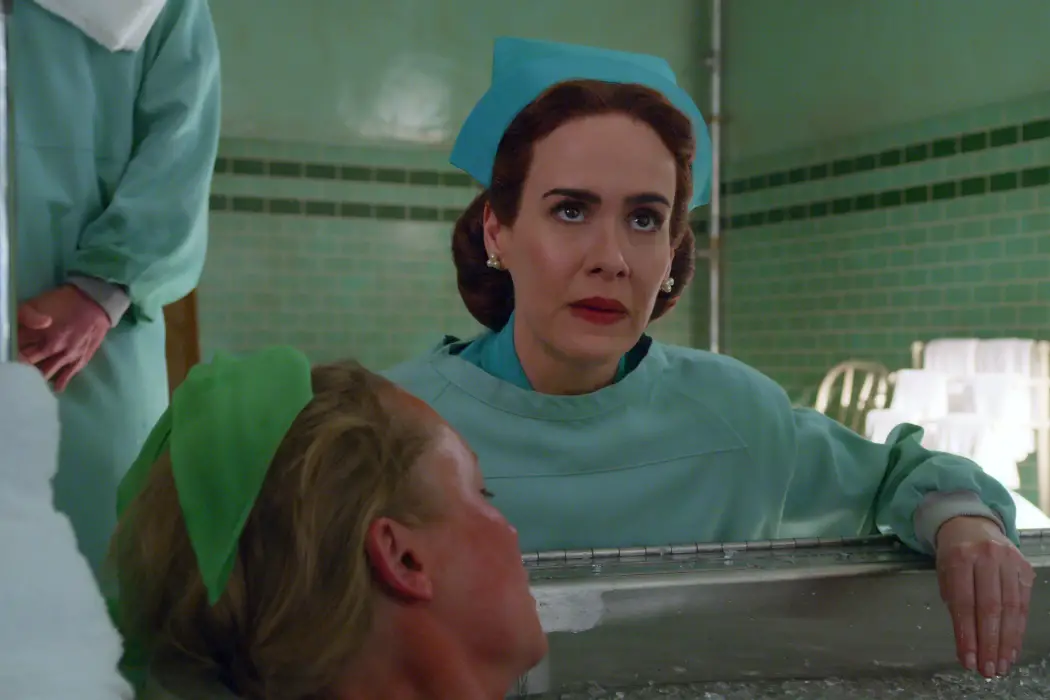
Stephanie Archer is 39 year old film fanatic living in…
With COVID-19 delaying practically ever film and TV premiere – much of which has only just begun filming or has been moved to 2021 altogether – many have been left without their most anticipated and their most ritualistic. American Horror Story is one of those series that was unable to escape the pandemic’s effects, its premiere pushed to next year, and seemingly nothing to replace the void it has left this Halloween season. But leave it to Ryan Murphy to still have some tricks up his sleeves.
Already rumored to be plotted out for four seasons, Murphy has teamed up with Netflix to bring Ratched, a horrifically entertaining origin story surrounding the rise of the most iconic nurses in cinema – Mildred Ratched of One Flew Over the Cuckoos Nest. And right from the opening scene, it feels like a Ryan Murphy project, the color palette, cinematography, and framing echoing the opening season for AHS, yet with its new distribution platform allowing for Murphy and his team to stretch outside of the constrained boxes of censorship, giving more gore than before. It’s not overly done mind you, just enough so you know they are in a new playground.
The Backstory
There are similarities and a few callbacks to Murphy’s previous works, actors returning (Sarah Paulson, Finn Wittrock, Jon Jon Briones) and nods to horror film’s in the past, but the feeling of one, in particular, is an overarching air that weaves in and out of each scene and episode structure. While not as immediately evident from the show’s beginning, Ratched owes much of its success to AHS: Asylum, the series second season. Though as much as there are feelings of familiarity and moments of “aha!”, Ratched is allowed its own identity and moment to shine. There are Easter eggs for sure, but the series is not about the past, it is about the now – it is about Ratched.
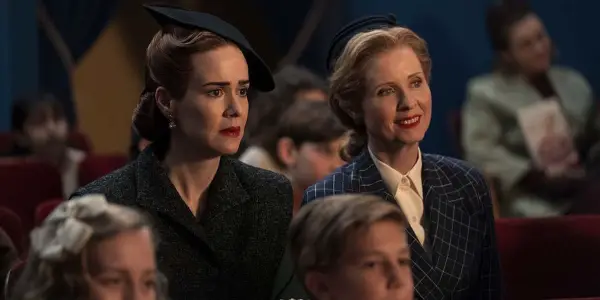
The series opens with a brutal murder, one that brings Wittrock back to the villainous roots we saw back in AHS: Freakshow, though here there is a deeper complexity than his previous clown killer. Facing the death penalty for his crimes, Edmund Tolleson is sent to Lucia State Mental Hospital to receive an evaluation to decide whether he is fit to stand trial. Faced with pressure from political aspirations and aspirations of medical advance, Edmund finds himself trapped in a stronghold of right and wrong, both with himself and those around him.
While Edmund’s story is one that is a central aspect of the series, Mildred Ratched is the character driving our story forward. Ambitious, determined, and always planning, Ratched is a survivor and a fighter. With her wits about her, she has survived the front lines as a Nurse, bringing her desire to help those back home by wars end. As she seeks employment at Lucia, her intentions become more and more questionable, and her struggle with good and evil begins to weigh on herself and those around her.
The Ratched we are introduced to is not the one we have come to love and hate, but what she could be and will be.
A Success in all of its parts
Hands down, Ratched will have your attention. Its introduction is a ballet of chaos accompanied by a symphony of broken minds, spirits, and hearts – and only one person is pulling the strings. It is ominous, yet hypnotic, almost soothing while cautionary all the same. While this intro is not included until the second episode, the first allowed to deliver brutality and set the stage for the series, it becomes a vital part of setting the mood for each episode following.
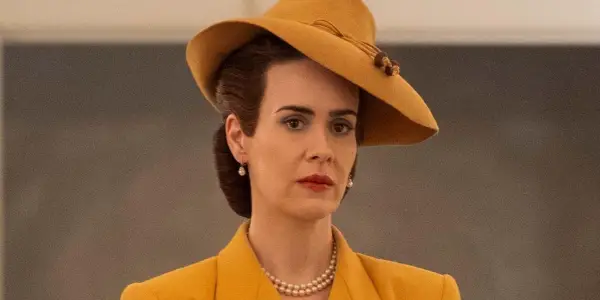
Color is a vital element of Ratched. While it bodes the cinematography one would come to expect in a Murphy production, Simon Dennis, Nelson Craft, and Andrew Mitchell had worked with him in the past, it is the colors green and red that find an uncharacteristic prevalence in Ratched. Omens, harbingers of death, or dark marks indicating evil, these monochromatic colors both take over scenes entirely or remain vibrant elements within the scene.
Cigarette dispensers are illuminated by green lighting, items (blankets, curtains, pins) display green in a variety of shades, and even the rooms characters find themselves in shades of green, almost as if they are closing in and consuming. Many times the green echoes the luminescent shade that would frequently outline the cold harden Maleficent from Disney’s Sleeping Beauty. The red is used similarly almost like a caution sign, warning its characters to stop what they are doing, almost indicating their undoing.
The score that accompanies the series from Mac Quayle, who returns to the Murphy fold after previously working on AHS, American Crime Story, and Feud, is reminiscent of the Golden Age of Hollywood, sweeping orchestras filled with doom and passion give the action on screen. In episode 6 “Got No Strings”, there is even a moment where the screen is momentarily filled with the eerie and foreboding nostalgia of Mark Snow’s score for The X-Files. With this score, Quayle is able to infuse a believability to the time period of the series, giving emotional height to the tension and performance on screen, all while weaving in and matching, with a masterstroke, the rhythm of the series and making itself known when at its greatest necessity.
If there is a time to say it, it is now – this is Sarah Paulson’s best role to date. She was born to play Nurse Ratched and for her performance alone I hope there will be more seasons to come. As a viewer, you see where she begins, as well as know where she ends up. With such a strong actress at the helm, it is an intense and intriguing journey not only to be introduced to the origins of the character but to see how she gets from point A to C. There is a complexity of Ratched infused by her depiction that makes you as a viewers struggle between hate and compassion for her – something that is strongly reminiscent of Louise Fletcher’s original performance but on a different plane. Paulson has excelled in all that Murphy has given her, and it has culminated to perfection. If you thought Lana from Asylum or Marcia Clark of American Crime Story were her best roles yet, get ready to have your mind changed.
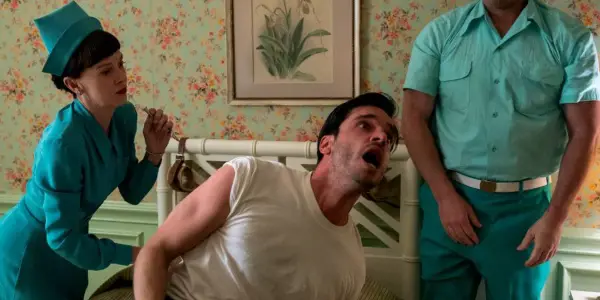
Yet, she is not the series only stand out. Jon Jon Briones (American Crime Story: The Assassination of Gianni Versace) brings the same vulnerability and confidence to screen for his portrayal of Dr. Hanover. Yet, where confidence dominated his previous character, there is a vulnerability that exudes, one that threatens his very way of life and career. His ambition is for the healing of others, while also for himself, and Briones balances each element well. Finn Wittrock (AHS, The Big Short) needs more villainous roles, he is as memorable as his first introduction to the Murphy Universe, yet here he is more complex, calling for audience compassion rather than accolades.
Cynthia Nixon (Sex and the City), Judy Davis (The Dressmaker), Sharon Stone (Basic Instinct, Casino) and Amanda Plummer (Pulp Fiction, Hunger Games: Catching Fire) round out a phenomenally predominate female cast. Each is a strong and resilient woman, and while flawed and thus wholly human, they are unafraid to embrace the world with what they have and find success in all they set out to achieve. They may bit at odds with one another, but they are proof that in a man’s world, the puppeteers bringing the puppets to life.
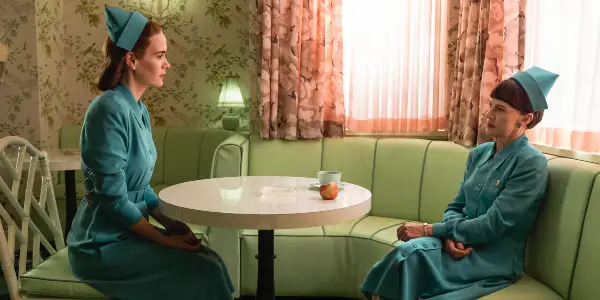
Ratched is not afraid to show each character’s ambiguity about what is right or wrong, whether it be on social issues, behavior, or belief. This is a series that examines not only a time period where mental illness was still a mystery but is applicable to the present to show have far we have come – and how far we have yet to go. In one moment, Ratched will show the treatments of the time to cure sodomy and homosexuality. Those who prefer the company of women subjected to hot and cold baths, the almost boiling water followed by the shock of the cold forcing behavior deemed fit and driving home the damaging effects of negative reinforcement. All the while, women who have judged those around them finding acceptance of those closest who are suffering from the same “infliction”. Murder is looked down upon in some cases, yet encouraged in others. Mental illness is overlooked and acceptable, that is until you subject yourself to the care of others – whether it be voluntary or involuntary. It calls into question the tendency for humanity to place morals and judgment on torahs, while continuing to live the life they deem so unacceptable.
Conclusion: Ratched
Ratched returns Murphy to his deliciously horrific TV roots, bringing the origin of an iconic character to life for a new generation. It will become a favorite for fans of American Horror Story alike, filling in the gap its absence this fall has left. Though it is not without its minor flaws. While easy to over look, the series does begin to come to a grinding halt, the romanticized violence and foundations of episode 6 “Got No Strings” of relationships causing the rhythm of the series to stall a bit. Ratched will leave a lot of questions for viewers, in the end, puttering out ever so slightly from the high it had created, leaving viewers intrigued for more, but missing the mark of suspense.
Even with these bumps in the road, Ratched is a viewer worthy series that is sure to acquire its own accolades, returning many to the story from whence it came and building anticipation for the potential of more to come.
Have you seen Ratched? What did you think? Let us know in the comments below!
Ratched will be released on Netflix on September 18, 2020.
Watch Ratched
Does content like this matter to you?
Become a Member and support film journalism. Unlock access to all of Film Inquiry`s great articles. Join a community of like-minded readers who are passionate about cinema - get access to our private members Network, give back to independent filmmakers, and more.













